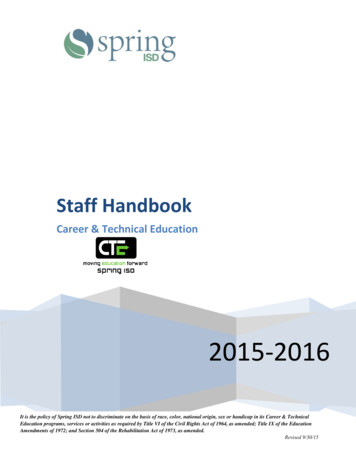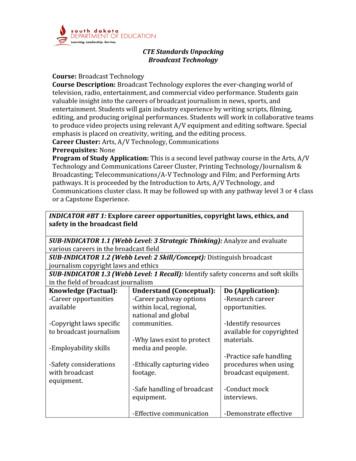CTE Standards Unpacking Nutrition And Wellness
CTE Standards UnpackingNutrition and WellnessCourse: Nutrition and WellnessCourse Description: Nutrition and Wellness educates students to make healthylifestyle choices for personal, family, and career success across the lifespan. Topicsinclude the impact of technology on nutrition, food choices, wellness and stressmanagement, meal planning and preparation, dietary guidelines, and food safety andsanitation practices.Career Cluster: Human ServicesPrerequisites: NoneProgram of Study Application: Nutrition and Wellness is a pathway course in theHuman Services career cluster, Personal Care Services, Family and CommunityServices/Mental Health Services and Early Childhood Development and Servicespathways. A student would participate in Introduction to Human Services prior toparticipation in this course. Nutrition and Wellness prepares a student to participate inadditional pathway courses in the personal care services, family and communityservices/mental health services, or early childhood development and servicespathways.INDICATOR #NW 1: Evaluate factors that influence nutritionSUB-INDICATOR 1.1 (Webb Level: 3 Strategic Thinking): Investigate the impact oftechnology and media on food and health practices.SUB-INDICATOR 1.2 (Webb Level: 4 Extended Thinking): Analyze the effects ofpsychological, cultural, economic and social influences on food choices and othernutrition practices.SUB-INDICATOR 1.3 (Webb Level: 2 Skill/Concept): Determine the effects ofnutrition on health, appearance, and peak performance.Knowledge (Factual):Understand (Conceptual): Do (Application):-Technology concerns,-As technology and demand -Discuss the impact ofissues, & topics:for new products increase,commercials, apps, and productconsumer food decisionssocial media on fooddevelopment,are becoming morerelated choices.individualizedcomplex.products, low-fat,-Compare and contrastlow-calorie, sugar-There are many factorsfactors related tofree, sugarthat influence our foodpersonal food choices.substitutes, etc.choices and nutritional social media, appspractices.-Research how cultureinfluences food choices.-Nutrients-Compare and contrast-Portion Controlhealthy and unhealthybody image.
-Nutrition Food Label-Personal Food Choices-EatingDisorders/Healthy BodyImage-Informed consumersconsider the effects of foodson health, appearance, andpeak performance whenmaking purchasingdecisions.-You are what you eat.-It is important to have ahealthy body image.Benchmarks:Students will be assessed on their ability to: Analyze the impact of media and technology on food choices. Evaluate the complexity of making food choices and decisions. Identify components of a healthy body. Assess the importance of proper nutritional intake and physical activity.Academic ConnectionsELA Literacy and/or Math StandardSample Performance Task Aligned to(if applicable, Science and/or Socialthe Academic Standard(s):Studies Standard):The Performance Task suggestions atright integrate one or more of thefollowing academic standards:ELA Reading Informational TextStandard: 9-12.RI.1 Cite strong, relevantevidenceELA Writings Standards: 9-12.W.6 Usetechnology to produce and publish; 912.W.10 Write routinely to research,reflect, and revise.ELA Speaking and Listening Standard: 912.SL.4 Present information, findings,and supporting evidenceEducational Technology Standard: 912.NC.3.1 Analyze intended andunintended impacts of a system (ie.social media’s impact on society).-Carry out the FCCLA STAR EventNutrition and Wellness project toevaluate the student’s diet. (9-12.RI.1,9-12.W.10)-Analyze the impact ofsocietal/personal/cultural values andeconomical situations on personal foodchoices. (9-12.RI.1, 9-12.W.10, 912.NC.3.1)-Create a presentation that analyzes theimpact of media on food choices. (912.RI.1, 9-12.W.6, 9-12.SL.4, 912.NC.3.1)-Create a poster on healthy body image.(9-12.RI.1, 9-12.W.6, 9-12.W.10, 912.SL.4, 9-12.NC.3.1)
INDICATOR #NW 2: Evaluate the needs of individuals and families in relationto health, nutrition, and wellness across the lifespanSUB-INDICATOR 2.1 (Webb Level: 1 Recall): Identify dimensions of wellnessSUB-INDICATOR 2.2 (Webb Level: 4 Extended Thinking): Apply current dietaryguidelines to meet nutrition and wellness needs.SUB-INDICATOR 2.3 (Webb Level: 1 Recall): Describe the effect of physical activityon health, appearance, and peak performance.SUB-INDICATOR 2.4 (Webb Level: 4 Extended Thinking): Analyze the effects offood and diet fads, food addictions, and eating disorders on wellness.Knowledge (Factual):Understand (Conceptual): Do (Application):-Health and Wellness-There are multiple-Complete and reflect onComponents: Social,dimensions to wellness.a wellness inventory.Environmental,Emotional, Spiritual,-Dietary guidelines are-Analyze recommendedIntellectual, Physicaldesigned to meet currentdietary allowances.nutritional and wellness-Nutrition Health Riskneeds.-Analyze a food productfor nutritional content.-Diet related diseases-Physical activity is a vitalpart of any health plan.-Assess case studies for-Dietary Guidelines fordifferent characteristicsAmericans-Nutrition consumption isof eating disorders.correlated to nutritional-MyPlatehealth risks.-Create a personalphysical fitness plan.-Recommended DailyAllowances-How to read food labels-Eating disorders andtheir effects on healthysuch as anorexia, bulimia,and binge eatingBenchmarks:Students will be assessed on their ability to: Define the dimensions of wellness. Apply the wellness dimensions to personal life. Identify how physical activity is a vital part of their health plan. Evaluate how nutrition consumption is correlated to nutritional health risks.
Academic ConnectionsELA Literacy and/or Math StandardSample Performance Task Aligned to(if applicable, Science and/or Socialthe Academic Standard(s):Studies Standard):-Create a Meal Plan and analyze how itThe Performance Task suggestions atmeets nutritional standards. (9-12.RI.8,right integrate one or more of the9-12.W.1, 9-12.SL.4)following academic standards:-Compare and contrast food products forELA Reading Informational Textnutritional and price value. (9-12.RI.8,Standard: 9-12.RI.8 Evaluate an9-12.W.2, 9-12.W.7)argument.assessing whether thereasoning is valid-Propose a redesign of the MyPlatemodel to incorporate physical activityELA Writings Standards: 9-12.W.1into daily life and support yourWrite arguments to support claims ORsuggestions through writing. (9-12.RI.8,9-12.W.2 Write9-12.W.1, 9-12.W.2, 9-12.W.7, 9informative/explanatory texts to12.SL.4)examine and convey complex ideas; 912.W.7 Conduct short as well assustained researchELA Speaking and Listening Standard: 912.SL.4 Present information, findings,and supporting evidenceINDICATOR #NW 3: Evaluate factors that affect food safety.SUB-INDICATOR 3.1 (Webb Level: 4 Extended Thinking): Apply practices topromote safe food handling.SUB-INDICATOR 3.2 (Webb Level: 1 Recall): Describe food borne illness that causehealth issues.Knowledge (Factual):Understand (Conceptual): Do (Application):-Food Borne Illnesses-It’s important to follow-Recognize food safetyproper food handling andhazards and how to-Federal Food Safetysanitation procedures toprevent them.Agencies: CDC, FDA,avoid foodborne illness.USDA, FTC, NMFS, Etc.-Correlate federal-It is vital to wash youragencies and their roles-Food Temperaturehands prior to handling any in the area of food safety.Danger Zonefood.-Interpret video for foodsafety hazards.
-4 C’s to Food Safety(Clean, Cook, Chill, CrossContamination/Separate)-It is vital to wash produceprior to preparation orconsumption.Food that is nottemperature controlled canpose a health risk.-Analyze variousscenarios fortemperature-based foodsafety concerns.Benchmarks:Students will be assessed on their ability to: Determine cause and effect of unsafe food handling and risk of foodborneillness. Describe the importance of food safety procedures. Classify federal agencies roles in food safety. Synthesize knowledge of safe food handling to identify and solve food safetyhazards.Academic ConnectionsELA Literacy and/or Math StandardSample Performance Task Aligned to(if applicable, Science and/or Socialthe Academic Standard(s):Studies Standard):-Create a product (video, poster,The Performance Task suggestions atAnimoto, Most Wanted brochure) aboutright integrate one or more of thea food borne illness. (9-12.RI.2, 9following academic standards:12.W.2, 9-12.W.6, 9-12.SL.4)ELA Reading Informational TextStandard: 9-12.RI.2 Determine thecentral idea of a text-Compose a PSA about food safetyprocedures. (9-12.RI.2, 9-12.W.2, 912.W.6, 9-12.SL.4)ELA Writings Standards: 9-12.W.1Write arguments to support claims OR9-12.W.2 Writeinformative/explanatory texts toexamine and convey complex ideas; 912.W.6 Use technology to produce andpublish-Match federal agencies to their roles inthe area of food safety.ELA Speaking and Listening Standard: 912.SL.4 Present information, findings,and supporting evidence-Set up a CSI Crime scene with variouskitchen hazards that students need toidentify. Students need to defend theirsuggested changes to bring safety to thescene. (Can use pictures of hazards, on aPowerPoint or actual situation in aclassroom kitchen). (9-12.W.2, 912.SL.4)
INDICATOR #NW 4: Demonstrate ability to acquire, handle, and utilize foods tomeet nutrition and wellness needs of individuals and families across thelifespan.SUB-INDICATOR 4.1 (Webb Level: 2 Skill/Concept): Plan and prepare a mealincorporating nutritional guidelines.SUB-INDICATOR 4.2 (Webb Level: 2 Skill/Concept): Demonstrate ability to select,store, prepare, and serve nutritious and aesthetically pleasing foods.SUB-INDICATOR 4.3 (Webb Level: 2 Skill/Concept): Use kitchen tools andequipment in a proper and safe manner.Knowledge (Factual):Understand (Conceptual): Do (Application):-Personal nutritional-When planning a meal, it is -List in order the steps toneedsimportant to considerplan and prepare ahealth and nutritionnutritious meal.-Usage and safety ofguidelines.kitchen tools and-Match the kitchen toolequipment-Nutritious meal planningto the proper usage.and preparation requires-Selection, preparation,many steps.-Identify what tools andand storage of foodequipment would be-Improper use of kitchenneeded to prepare atools poses significantmeal.danger.-Tour a grocery store tomake selections based onfactors such as: cost, unitcost, quality, andnutritional content.Benchmarks:Students will be assessed on their ability to: Apply knowledge and skills to safely plan and prepare a nutritious meal. Categorize kitchen tools and equipment based on their proper usage. Show the ability to select foods based cost, quality, and nutritional content.Academic ConnectionsELA Literacy and/or Math StandardSample Performance Task Aligned to(if applicable, Science and/or Socialthe Academic Standard(s):Studies Standard):-Practice knowledge and skills inThe Performance Task suggestions atcooking labs.right integrate one or more of thefollowing academic standards:-Write out the steps needed to prepare anutritious meal. (9-12.W.10)
ELA Reading Informational TextStandard: 9-12.RI.1 Cite strong, relevantevidence-Reflect on data collected at a grocerystore based on specific criteria. (912.RI.1, 9-12.W.7, 9-12.W.10)ELA Writings Standards: 9-12.W.7Conduct short as well as sustainedresearch; 9-12.W.10 Write routinely toresearch, reflect, and revise-Prepare a nutritious meal or food itemin a lab setting. Reflect on the processand share your findings. (9-12.W.10, 912.SL.4)ELA Speaking and Listening Standard: 912.SL.4 Present information, findings,and supporting evidenceAdditional Resources SuperTracker https://supertracker.usda.gov/ Choose MyPlate https://www.choosemyplate.gov/ Dietary Guidelines for Americans nes-americans How to Understand and Use the Nutrition Facts labeling/labelingnutrition/ucm274593.htm Fed Up Documentary FCCLA Projects ns.php Six Dimensions of Wellnesshttp://www.nationalwellness.org/?page Six Dimensions Food Safety Guidelines https://www.foodsafety.gov/keep/index.html Food Borne Illness l Dove Campaign for Real .html Common Sense Media Children, Teens, Media, and Body ldren-teens-media-andbody-image U.S. Food and Drug Administration https://www.fda.gov/ The 4 C’s to Food Safety http://www.safefood.eu/Food-Safety/The-4-Cs.aspx U.S. Dept. of Ag https://www.usda.gov/ Glo Germ http://www.glogerm.com/ FDA/NSTA Science and our Food Supply t.htm CDC Solve the Outbreak .html
CTE Standards Unpacking Nutrition and Wellness Course: Nutrition and Wellness Course Description: Nutrition and Wellness educates students to make healthy lifestyle choices for personal, family, and career success across the lifespan. Topics include the impact of technology on nutrition, food choices, wellness and stress
12 Summer Data -410 CTE Attendance: * Collected only in the summer submission. * 410 Attendance requires the student has a valid CTE Indicator code on the 101 record. * Each student enrolled for more than two hours in a valid CTE course must have a 410 record. * "V" Codes: * V1 45-89 ave. minutes per day in a CTE course * V2 90-149 ave. minutes per day in a CTE course
CTE standards and 13 states and two territories have state-approved postsecondary standards. Only two states and one territory have CTE standards that are fully aligned between secondary and postsecondary systems. X The majority of states have the authority to adopt both secondary and postsecondary CTE standards, although most
New York State Work Experience Requirements by CTE Title SECTION C. BECOMING A CTE TEACHER C1. CTE Resume Example C2. The CTE Hiring Process C3. Applying for Salary Increase SECTION D. APPLYING FOR A CTE TEACHING CERTIFICATION D1. Steps to Applying for a Trans-A Certificate with NYSED D2. Trans-A Requirements for All NYS Teacher Applicants D3.
CTE Overview 3 CTE Department Contacts 4 Career Pathways 2015-2016 5 CTE Course List 2015-2016 6 CTE Curriculum & Resources 8 Professional Development Requirements 9 CTE Advisory Board 14 Career Cluster Coordinator Guidelines 15 Career & Technical Student Organizations (CTSOs) & Sponsorship 18 Certification Reporting 23
Virginia includes CTE courses within 16 career clusters, each with multiple pathways designed by the school divisions. For example, the Health Science career cluster may include pathways for therapeutic services, biotechnology, or diagnostic services. CTE credential. A CTE credential certifies that a student has mastered specific CTE content.
CTE Standards Unpacking Broadcast Technology Course: Broadcast Technology Course Description: Broadcast Technology explores the ever-changing world of television, radio, enter
past few years have systematized and revamped their standards in the program of career and technical education (CTE). Nearly every state in the union has worked hard to redesign its CTE standards into coherent courses and plans of study, organized for the most part into the 16 Career Clusters defined by Advance CTE. In addition, state .
the welfarist objective assumed in modern Mirrleesian theory. In normative terms, the shift from the classical bene–t-based view to the dominant modern approach, which pursues so-called "endowment taxation," is quite substantial. Under the modern approach, an individual s income-earning ability is taken as a given, and as ability makes it .























